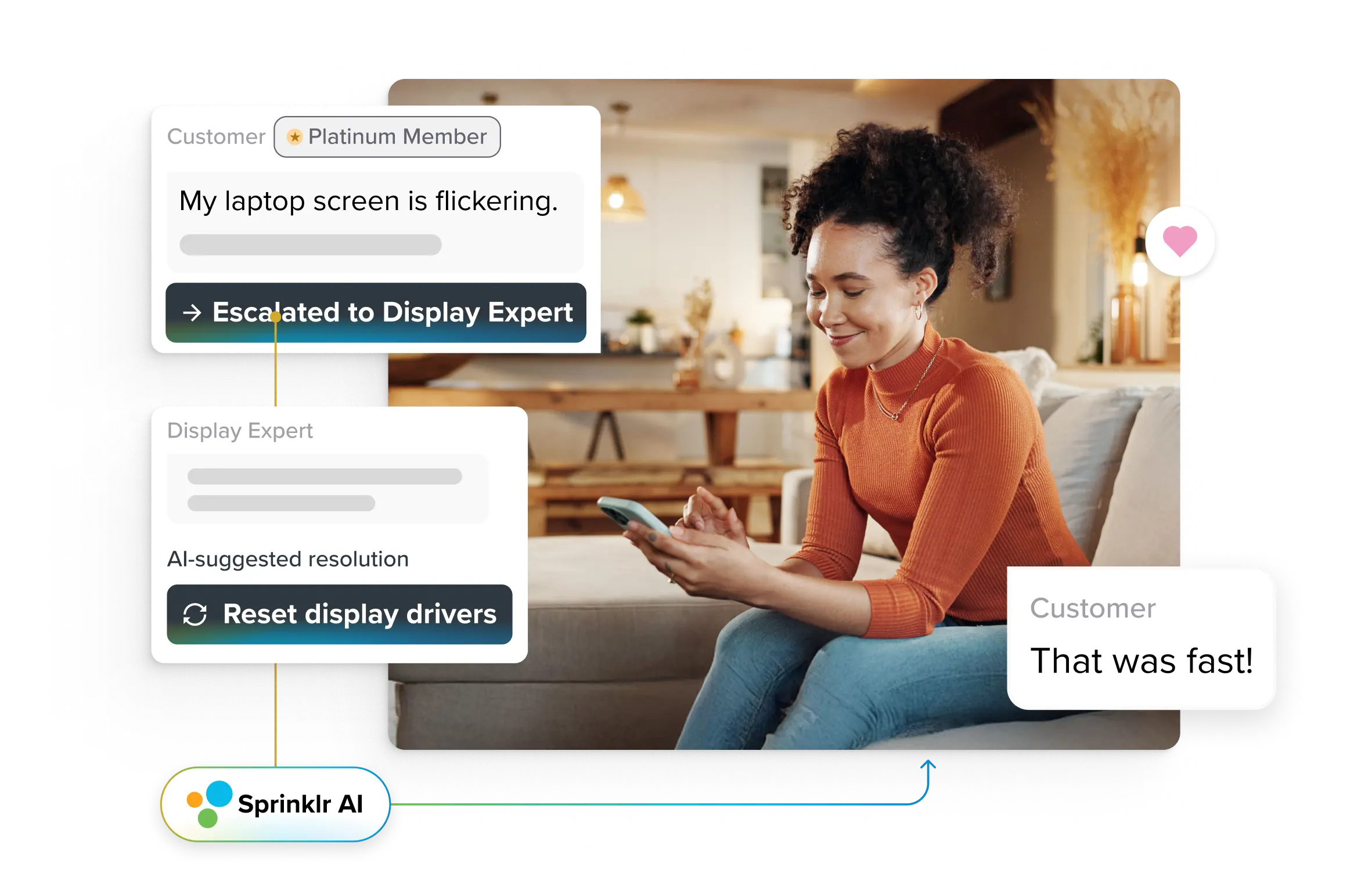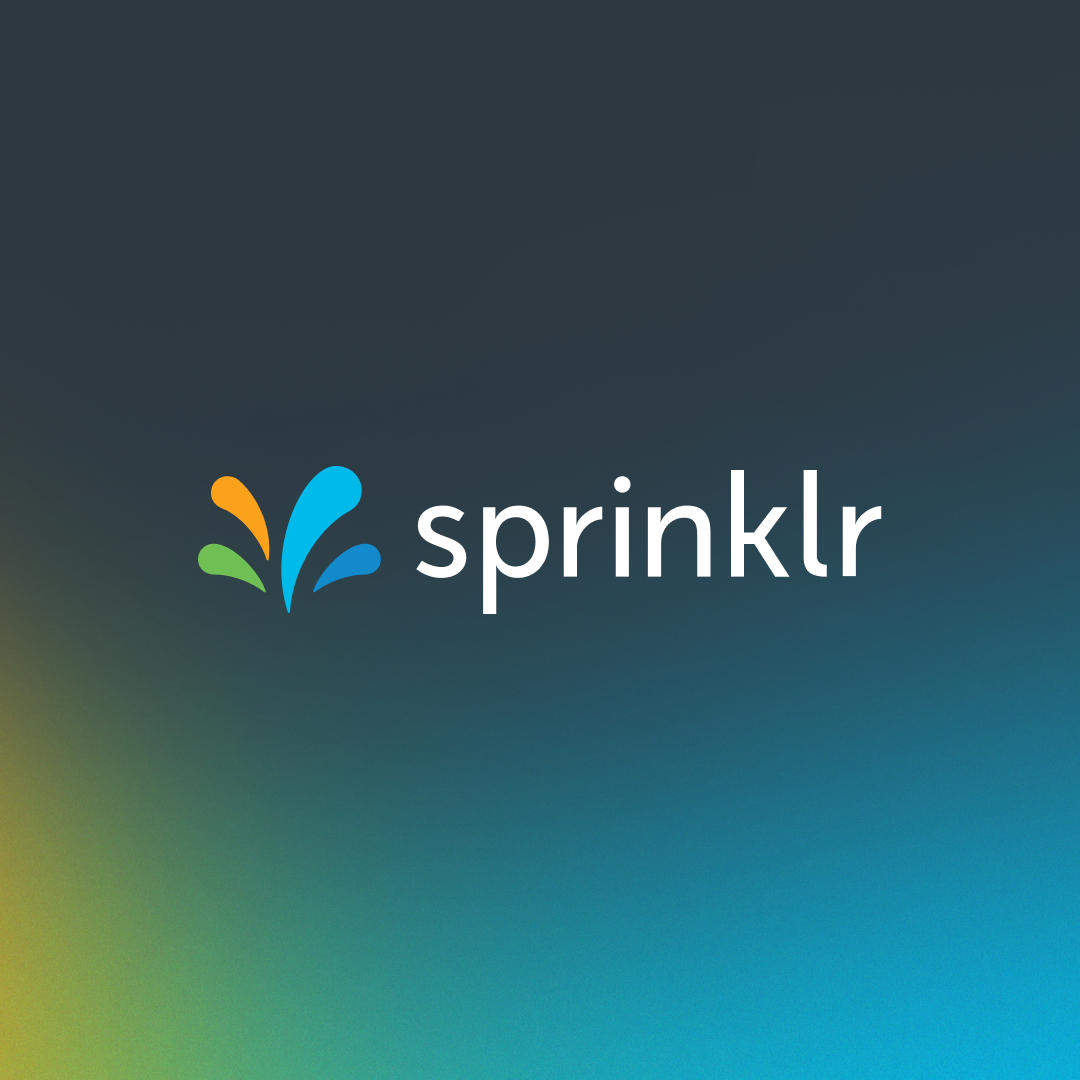Transform CX with AI at the core of every interaction
Unify fragmented interactions across 30+ voice, social and digital channels with an AI-native customer experience platform. Deliver consistent, extraordinary brand experiences at scale.

Contact center services: Examples + Tips
In today's business world, standing out often boils down to how well you treat your customers. That's where contact center services come into play. They've gone from being just a cost center to the heart of the customer experience, especially with the rise of AI.
Every interaction with your customers matters and that's why businesses, big and small, are doubling down on their contact center efforts. Whether you're a startup wondering if you need a contact center or a seasoned pro looking to level up your game, you're in the right spot.
Let's delve into the latest trends and best practices in contact center services, offering insights from top industry examples and expert tips.
What are contact center services
Contact center services encompass a variety of technology-driven customer-facing activities, facilitating interactions across various contact center channels. From addressing inquiries and support requests to driving sales and gathering feedback, contact center services play a pivotal role in fostering customer engagement within businesses.
Today, customer experience reigns supreme and with advancements in technology like AI and contact center automation, contact center services have evolved to offer greater efficiency, scalability and personalization, further cementing their importance in the business landscape.
However, ensuring the seamless operation of contact center services is a collective effort. While the customer service team oversees day-to-day operations, IT professionals manage the technical infrastructure and systems that support contact center operations. Marketing teams also come into play as they provide insights into customer preferences and behavior, with operations teams focusing on optimizing processes and customer service workflows to enhance efficiency and customer satisfaction.
Contact center to contact center as a service (CCaaS)
Traditionally, contact centers relied on onsite hardware and software tools, necessitating substantial upfront investments and IT support. However, as communication channels expanded beyond voice, technologies like interactive voice response (IVR) and customer relationship management (CRM) systems emerged, managing the growing complexity of customer interactions.
In the early 2000s, businesses started adopting cloud-based platforms that offered numerous advantages over traditional on-premises solutions. These cloud-based solutions provided businesses with greater flexibility, allowing them to quickly and easily adjust their capacity according to their business needs.
Today, CCaaS solutions are hugely popular and offer numerous advantages. They allow you to easily adjust your capacity according to your needs, pay only for the resources you utilize and eliminate the need for expensive hardware and IT support.
Contact center vs. call center
While "contact center" and "call center" are often used interchangeably, they have notable differences.
Aspects | Contact center | Call center |
Channels supported | Supports multiple communication channels such as voice calls, email, chat, social media, SMS, etc. | Primarily focuses on handling inbound and outbound voice calls. Other channels may not be integrated. |
Scope of operations | Provides a comprehensive range of customer service functions beyond voice calls, including customer support, sales and technical assistance. | Primarily focuses on handling telephone-based interactions, typically limited to straightforward customer support or sales functions. |
Customer engagement | Emphasizes holistic customer engagement across various customer touchpoints, aiming for a seamless and integrated experience. | Primarily focuses on resolving customer inquiries or issues efficiently within the confines of a phone call. |
Technology integration | Utilizes advanced technologies like AI, automation and contact center analytics to optimize operations and enhance customer experiences across channels. | Relies primarily on traditional telephony systems and may have limited integration with newer communication technologies. |
Flexibility | Offers greater flexibility in terms of scalability, agent mobility and channel expansion to adapt to changing customer needs and business requirements. | May lack the flexibility to quickly adapt to new channels or scale operations without significant infrastructure changes. |
🔍Deep Dive: Call Center Vs. Contact Center: What's the Difference in 2024?
Top 7 examples of contact center services
According to customer service statistics, around 80% of American customers prefer a combination of speed, convenience, knowledgeable help, and friendly service to make their experience memorable. This highlights the importance of contact center services in ensuring positive customer experience. Let's discuss seven essential examples of contact center services widely used by businesses to engage with customers.
1. Voice calling
Contact centers leverage cloud telephony, powered by VoIP (Voice over Internet Protocol), to facilitate voice calls. This technology converts analog voice signals into data packets and transmits them over the internet, seamlessly connecting callers to their intended recipients.
Voice calling serves two primary use cases in contact centers:
- Inbound support: Inbound customer support addresses incoming inquiries, issues and customer requests via phone. Agents assist with product information, troubleshooting, order tracking and other support-related tasks to ensure prompt resolution and customer satisfaction.
- Outbound sales and telemarketing: Companies utilize voice calling for outbound sales and telemarketing initiatives, proactively reaching out to potential customers to promote products, services, or special offers. Agents engage with prospects, qualify leads and drive sales conversions through effective communication and persuasion techniques.
Key features of voice calling in contact center services include:
- Predictive dialing: Auto dialers optimize outbound call efficiency by bulk-dialing numbers from contact lists, ensuring agents always have callers readily available.
- Call recordings: Stored for quality assurance, contact center compliance and training purposes.
- Call analytics: Advanced call analytics provide insights into key performance metrics such as contact rates, conversion rates and average hold time.
- Sentiment analysis: AI-powered sentiment analysis identifies gaps in products, services and agent conversations, enabling you to take corrective actions, reduce call volume and enhance customer experiences.
💼 What makes it indispensable: Despite the remarkable advancements in customer service, voice remains the predominant and preferred channel. When facing complex inquiries, articulating the issue verbally is often more efficient than typing it out. Phone conversations allow for a natural flow of dialogue, facilitating quicker resolution and smoother interactions. Moreover, individuals typically seek human interaction for reassurance and support during urgent or stressful situations.
Do you know: Businesses often face the challenge of dealing with a high volume of calls and queries daily. This can lead to agent burnout. So, companies rely on automatic call distribution systems to distribute calls equally among agents while intelligently routing calls to the agent with the right skills.
However, Sprinklr customers have an added advantage. They can route repeat calls to the same agent to ensure continuity and provide a seamless customer experience. Know more about call routing.
2. Short message service
SMS functionality is integral to contact center services as it enables you to communicate with customers via text messages, delivering personalized updates, alerts and promotional messages directly to their mobile devices. This direct and concise communication is ideal for providing time-sensitive information and engaging with customers on the go.
Key features:
- Personalization: SMS functionality allows you to send tailored messages to individual customers, enhancing relevance and engagement. This level of personalization is a powerful tool, giving you the confidence to engage customers in a way that resonates with them.
- Automation: Automate SMS updates for timely delivery of critical business information such as order confirmations and appointment reminders.
- Tracking and analytics: It lets you monitor delivery rates and response rates to optimize SMS campaigns and achieve better results.
- Integration: The best part of SMS functionality is its seamless integration within your contact center CRM system. This data-driven approach to customer engagement enhances your customer communication and reassures you about the ease of implementation, making it a win-win situation for your business.
💼 What makes it indispensable: SMS services facilitate faster actions and more accessible communication between businesses and customers, with unparalleled reach and effectiveness.
3. Omnichannel customer service
Omnichannel customer engagement is a strategy that seamlessly integrates multiple communication channels to provide a unified and consistent experience across all touchpoints. Unlike multichannel contact centers, which may operate in silos, omnichannel engagement aims to create a cohesive and interconnected customer journey, allowing your customers to transition between customer service channels effortlessly while maintaining continuity. Key features:
- Social listening: It lets you monitor brand mentions and conversations proactively across social channels to address issues before they escalate.
- Centralized inbox: Manage all social media interactions in a single, unified inbox for improved efficiency and seamless communication.
- Intelligent routing: Automatically assigns messages to appropriate agents or teams based on the nature of inquiries, ensuring personalized and efficient responses.
- Sentiment analysis: You can analyze customer sentiments to identify potential issues and tailor responses accordingly.
💼 What makes it indispensable: Omnichannel approach enhances convenience, accessibility and personalization, allowing you to meet individual needs effectively. Moreover, omnichannel engagement drives efficiency by providing agents with a unified view of customer data, leading to faster and more accurate responses.
Good to know: With modern AI-powered omnichannel routing software, you can effortlessly set up seamless routing logic for customer case management across all communication channels. This helps optimize your workforce's efficiency by eliminating the need for channel-specific configurations. You can easily monitor your support operations using a centralized contact center dashboard, which provides real-time insights into key metrics like CSAT, response time, backlog trend and more.
4. Technical support and helpdesk services
Technical support and helpdesk services specialize in assisting customers with technical issues, software troubleshooting and product-related inquiries. Knowledgeable agents provide step-by-step guidance, remote assistance and problem resolution to ensure smooth operation and optimal usage of products or services. Key features:
- Ticketing system: Utilizes a ticketing system to track and prioritize customer inquiries, ensuring timely resolution.
- Knowledge base: Provides customer self-service options through a comprehensive knowledge base containing troubleshooting guides, FAQs and tutorials.
- Remote desktop support: Offers remote assistance to diagnose and resolve technical issues efficiently, minimizing downtime.
- Escalation procedures: Implements escalation procedures to route complex issues to specialized support teams for resolution.
💼 What makes it Indispensable: Technical support and helpdesk software play a critical role in ensuring customer satisfaction and maintaining the functionality of products and services. By providing timely and effective technical assistance, you can minimize disruptions, enhance customer experiences and build customer loyalty.
💡 Pro Tip: When implementing helpdesk software, prioritize flexibility and customization by assessing your organization's current and future needs. Opt for a modular solution that allows tailoring workflows, ticketing systems and reporting functionalities. Leverage integrations and APIs to connect your helpdesk software with existing systems, future-proof your support operations and scale efficiently.
5. Virtual assistant and self-service solutions
Virtual assistants and self-service solutions leverage AI-powered chatbots, IVR systems and online knowledge bases to provide customers with automated assistance and self-service options. These tools handle routine inquiries, FAQs and simple transactions, freeing up contact center agents to focus on more complex tasks and enhancing overall efficiency and customer satisfaction.
Key features:
- Chatbots: AI-powered chatbots provide instant responses to customer inquiries, delivering personalized assistance and guiding users through self-service options.
- Interactive voice response (IVR): IVR systems automate call routing and provide self-service options through voice prompts, allowing customers to access information and perform tasks without agent assistance.
- Transactional support: This empowers customers to perform transactions such as account management, bill payments and order tracking through self-service portals and automated systems.
💼 What makes it indispensable: Virtual agents and self-service solutions enhance customer convenience and accessibility by providing instant access to information and support resources. By automating routine tasks and inquiries, you can significantly boost customer response times, improve efficiency and deliver seamless customer experiences across channels.
6. Conversational IVR
Conversational IVR systems leverage natural language processing (NLP) and AI to provide more intuitive and personalized customer interactions over the phone. Instead of navigating through complex menu options, customers can speak naturally and describe their issues, allowing the system to understand and route their call to the appropriate department or provide relevant information.
Key features:
- Natural language understanding (NLU): Advanced NLU technology interprets and understands customer queries, enabling more accurate and efficient call routing.
- Contextual awareness: Maintains context throughout the conversation to anticipate customer needs and provide relevant information or assistance.
- Personalization: Customizes IVR interactions based on customer profiles and previous interactions to deliver personalized and tailored experiences.
- Seamless integration: Integrates IVR systems with other contact center technologies and CRM systems to streamline call routing and provide agents with relevant customer information.
💼 What makes it indispensable: Conversational IVR significantly reduces average handle times, improves first-contact resolution and enhances overall customer satisfaction.
7. Social customer service
Social media customer service is a crucial component of modern contact center operations, allowing you to engage with customers across various social media platforms. From Facebook and Twitter to Instagram and LinkedIn, you can actively monitor, respond to and manage customer inquiries, comments and messages to ensure a seamless and personalized experience.
Key features:
- Centralized inbox: This feature manages all social media interactions in a single, unified inbox, allowing agents to view, respond to, and track customer inquiries and comments efficiently.
- Intelligent routing: Automatically routes social media messages to appropriate agents or teams based on keywords, topics or customer preferences, ensuring prompt and accurate responses.
- Analytics and reporting: Utilizes social media analytics tools to track social media engagement metrics, monitor response times and measure customer satisfaction, enabling data-driven insights and performance improvements.
💼 What makes it indispensable: With social media's increasing prevalence in daily life, customers expect timely and personalized responses to their inquiries and feedback. By incorporating social media service into your customer service strategy, you can enhance brand visibility, build customer trust and foster long-term relationships, ultimately driving customer satisfaction and loyalty.
Good to know: Whether your customers prefer to engage on Facebook Messenger, Twitter DMs or Instagram comments, Sprinklr's social customer service software ensures you can meet them wherever they are. It brings conversations across multiple channels in a single view to ensure effortless responses, agent efficiency and accuracy.
Moreover, the flexible SDKs and APIs empower you to seamlessly add new channels, including proprietary applications unique to your business. You can scale up channels within minutes to meet the rapid demands of your growing customer base.

Benefits of contact center services
Contact center services offer various benefits to businesses, which are as follows:
Enhanced customer experience: Contact center services help you offer seamless omnichannel customer experiences, allowing customers to interact with your brand via their preferred channels – voice, email, chat, social media, you name it. This translates to happier customers, as they can easily reach you for support anytime, anywhere.
Increased efficiency: Contact center services optimize resource allocation, reduce average hold times and improve first-call resolution rates by leveraging advanced technologies and streamlined processes, leading to greater operational efficiency.
Cost savings: Contact center services help you lower operational costs by minimizing the need for physical infrastructure, automating routine tasks and maximizing agent productivity through tools like predictive dialers and AI-powered chatbots.
Enhanced scalability: Contact center services allow you to easily scale your operations to accommodate fluctuating call volumes, seasonal demands and business growth without compromising service quality.
Actionable insights: Contact center services deliver strategic data and analytics on customer interactions, empowering you consumer insights. This wealth of information can guide strategic decision-making and fuel continuous improvement.
Transform customer experiences with contact center services
Today, keeping customers happy is more important than ever. But let's face it, managing all those calls, messages and social media interactions can feel like juggling flaming torches while riding a unicycle.
That's where Sprinklr Service comes in. Because it's not just about solving problems—it's about seizing opportunities.
With Sprinklr, you can manage all your customer interactions under one roof, making it easy to stay on top of things and deliver top-notch service every time.
However, don't take our word for it. Try it for yourself. The good part is that with a free trial, you can explore Sprinklr Service at your own pace. Ready to get started?
Frequently Asked Questions
Contact center services seamlessly integrate with existing CRM systems through APIs and connectors, ensuring smooth data flow and synchronization between platforms for comprehensive customer insights and streamlined workflows.
Scaling your contact center as your business grows is made easy with flexible cloud-based solutions that allow you to add new agents, channels, and features on-demand, ensuring scalability without disruptions.
Yes, contact center services support customers in multiple languages by offering multilingual support through language-specific queues, routing, and multilingual agents or translation features.
Contact center services handle high call volumes by implementing advanced queuing algorithms, predictive dialers, and interactive voice response (IVR) systems to efficiently distribute and manage incoming calls, minimizing wait times and optimizing agent productivity.
Agents using contact center services receive comprehensive training and ongoing support, including onboarding sessions, product demonstrations, and access to knowledge bases, online resources, and dedicated support teams to ensure proficiency and success in handling customer interactions.









